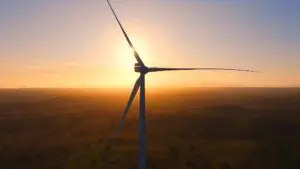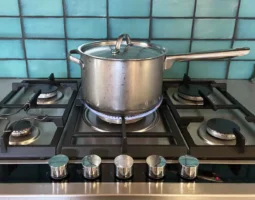New rules introduced by the Australian Energy Market Operator that require significantly more gas generation to operate when wind output is high in South Australia appear to signal the end of cheap wind energy in the state.
Normally, when wind output is high, prices in the state fall, or even go into negative territory. But on Tuesday morning, when the wind output jumped above 1,100MW the actual price of wholesale power in South Australia was above $150/MWh, with some 500MW being exported to Victoria.
Over the previous day, July 3, when the output of wind was consistently above 1,000MW, the average price of wholesale power in South Australia was more than $130/MWh, due to the need for extra gas plant, which forces the price higher.
The new AEMO requirement, quietly introduced in December, but not enforced until this week, requires three gas units to run when wind production is up to 1200MW, and four gas units when it is more than 1200MW.
If four gas units cannot be engaged, then excess wind power above 1200MW is curtailed, as occurred on Monday. Previously, it had advised that just two gas generators were needed, but appears to have taken a security-first approach.
South Australia in the past year has experienced the highest wholesale electricity prices in Australia, mostly due to the rising cost of gas, its higher dependence on gas-fired generation over other states, and because the market is dominated by just a few generation companies, who have been accused by network operators and the state government of deliberately withholding capacity and forcing up prices.
However, South Australia’s ability to use wind energy to balance out these periods of high prices caused by gas generators appears to be in jeopardy under this new rule. Normally, when there are high levels of wind generation, prices are low, or even into negative territory.
Professor Ross Garnaut, the climate policy expert and now chairman of Zen Energy, says that in the year after the closure of Northern coal generator last May, the price of wholesale electricity power was often below zero for the 12 per cent of the year when the wind blew hardest.
“The average price over this time was minus $29 per MWh (volume weighted). You heard correctly. Minus $29 per MWh,” Garnaut told an audience at a lecture at the Melbourne Energy Institute on Monday.
“Now that the Northern power station has closed, expansion of renewable energy in SA extends the number of hours when renewables set the price at very low levels. It reduces the average price of power without risk that it will cause a price spike by encouraging the departure of a coal generator.”
However, when the output of renewables is particularly weak and demand strong, the peaking gas generators come into play and push prices higher. In South Australia in the year after the closure of Northern, these conditions ruled for 35 per cent of the time, when average power prices were $171/MWh, Garnaut says.
His data is supported by research from the Climate and Energy College’s Dylan McConnell, which shows that in 2015, when wind generation was above 1,000MW, there were no high-priced events and the average price was less than $25/MWh.
“So certainly from an historical perspective – it is highly unusual for prices to be so high when wind generation is above 1000 MW,” he says.
Another graph above, from energy analyst Ketan Joshi, shows how gas prices have risen recently as wind output fell. Normally, this would be expected to be reversed as wind output rebounded.
But those negative pricing events may be a thing of the past – at least until new rules are introduced.
Over the last few days, when South Australia’s wind output blew constantly above 1,000MW, the prices stayed high, and it seems the new rules for the extra generators will now guarantee even higher wholesale prices for consumers in the state, who have long suffered the highest electricity prices in the country.
On Monday, when the price averaged above $130/MWh, despite the high wind output, it should be noted that prices were higher in both Victoria and Tasmania, and were only marginally above the level in NSW.
Queensland prices have fallen since the state government ordered the generators to change their bidding practices, a development that has underpinned the belief that bidding practices, more than anything, have been responsible for high wholesale electricity prices, and in turn higher retail bills.
Ironically, South Australia over the last three months has experienced low wind output, with Infigen Energy reporting that wind output from its operations in South Australia and NSW were more than 30 per cent below its long-term average. Tilt Renewables has reported similarly poor conditions.
Now, as the wind returns, the new rules – which had not been implemented beforehand due to the low wind output – means that prices will not fall as usual.
The state is now destined for a sustained period of high wholesale electricity prices, just as the Labor government heads into a state poll due by next March.
The high prices will benefit both gas generators and wind farm operators, but not consumers. It may also lend the argument that wind and solar with back-up are expensive, even though most studies suggest it would be cheaper than new fossil fuels if managed properly.
The new AEMO rules were flagged just one month after a review of the state’s power security indicated that two generators would be enough to operate at all times, including times of high wind.
AEMO says the new measure will be in place “until something else replaces it”, either until the shortfall in NSCAS (Network Support and Control Ancillary Services) is filled or alternate arrangements are made available through new markets.
“AEMO strongly believes this is a required and necessary initiative to maintain power system security during a period of rapid transformation,” a spokesman said in an emailed statement.
Franck Woitiez, the head of Neoen Australia, which is building the third of three wind farm stages at Hornsdale, for a total of 309MW, says policies need to be carefully designed so that they don’t incentivise side effects like high power prices, but rather achieve an overall critical risk mitigation.
On Monday morning, just over 250MW of wind capacity was constrained, from three wind farms – Waterloo, Bluff and North Brown that the AEMO dispatch mechanism judged to be the most expensive.
But curtailments could become even more marked in the future as more wind farms are added, such as the third stage of Hornsdale, and the Lincoln Gap wind farm near Port Augusta, and others.
New rules are being proposed that will require new wind and solar farms – and any new fossil fuel generators – to be able to provide fast-repose services to system faults, but this is not expected to add significantly to the costs of those operations.
But in the long term, the renewable energy industry is convinced that the combination of wind and solar and storage will be cheaper than relying on gas.
Reach energy says the combination of wind and solar is already cheaper than gas and will be “well below” $100/MWh. Lyon Solar is also pushing ahead with solar and storage projects. Excess wind energy can be spilled into battery storage, or pumped hydro, if available.
In a later statement, state energy minister Tom Koutsantonis said that the recent pricing is not related to the changed AEMO operating procedure, “rather it is the outcome of a range of factors, including high gas prices and limited competition” in the South Australian market.
“Our $550 million energy plan seeks to promote more competition in the South Australian market, including through the construction of Australia’s largest battery, which will allow cheap wind energy to be dispatched to the grid around-the-clock, adding competition during periods of high demand and putting downward pressure on prices,” he said in a statement.











